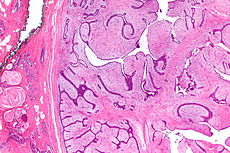- Phyllodes tumor
-
Phyllodes tumor Classification and external resources 
Micrograph of a phyllodes tumor (right of image) with the characteristic long clefts and myxoid cellular stroma. Normal breast and fibrocystic change are also seen (left of image). H&E stain.ICD-10 C50, D24, D48.6 ICD-9 217 ICD-O: M9020 DiseasesDB 3396 eMedicine med/500 MeSH D003557 Phyllodes tumors (from Greek: phullon leaf), also cystosarcoma phyllodes, cystosarcoma phylloides and phylloides tumor, are typically large, fast growing masses that form from the periductal stromal cells of the breast. They account for less than 1% of all breast neoplasms.
Contents
Classification
Phyllodes tumors are a fibroepithelial tumor composed of an epithelial and a cellular stromal component. They may be considered benign, borderline, or malignant depending on histologic features including stromal cellularity, infiltration at the tumor's edge, and mitotic activity. All forms of phyllodes tumors are considered breast cancer, as even the benign form is regarded as having malignant potential. They are also known as serocystic disease of Brodie.
They are classified as a fibroepithelial tumor by ICD-O, but not by MeSH.
Approximately 60-70% of examined tumors are benign, the proprotion of benign cases is higher in young women.[1]
Presentation
This was predominantly the tumor of adult women, with very few examples reported in adolescents. Patients typically present with a firm, palpable mass. These tumors are very fast growing, and can increase in size in just a few weeks. Occurrence is most common between the ages of 40 and 50, prior to menopause. This is about 15 years older than the typical age of patients with fibroadenoma, a condition with which phyllodes tumors may be confused. They have been documented to occur at any age above 12 years.
Treatment
The common treatment for phyllodes is wide local excision. Other than surgery, there is no cure for phyllodes, as chemotherapy & radiation therapy are not effective. The risk of developing local recurrence or metastases is related to the histologic grade, according to the above-named features. Despite wide excision a very high percentage of surgeries yielded incomplete excision margins that required revision surgery.[1]
One study has suggested that total mastectomy is more effective than breast-conserving surgery.[2]
A recent study (Aug 2009) by Barth et al. suggests that radiation treatment after breast-conserving surgery with negative margins significantly reduces the local recurrence rate for borderline and malignant tumors.[3]
Spectrum
Phyllodes tumors are considered to be on a spectrum of disease[4] that consists of fibroadenoma, fibroadenoma variant and benign phyllodes. Some would extend the spectrum to include malignant phyllodes tumors and frank sarcoma.[citation needed]
References
- ^ a b Guillot, E.; Couturaud, B.; Reyal, F.; Curnier, A.; Ravinet, J.; Laé, M.; Bollet, M.; Pierga, J. Y. et al. (2011). "Management of Phyllodes Breast Tumors". The Breast Journal 17 (2): 129–137. doi:10.1111/j.1524-4741.2010.01045.x. PMID 21251125.
- ^ Belkacémi Y, Bousquet G, Marsiglia H, et al. (2007). "Phyllodes Tumor of the Breast". Int J Radiat Oncol Biol Phys 70 (2): 492. doi:10.1016/j.ijrobp.2007.06.059. PMID 17931796. http://linkinghub.elsevier.com/retrieve/pii/S0360-3016(07)01175-3.
- ^ Barth RJ Jr, Wells WA, Mitchell SE, Cole BF (2009). "A prospective, multi-institutional study of adjuvant radiotherapy after resection of malignant phyllodes tumors.". Ann Surg Oncol. 16 (8): 2288–94. doi:10.1245/s10434-009-0489-2. PMID 19424757.
- ^ Deen SA, McKee GT, Kissin MW (1999). "Differential cytologic features of fibroepithelial lesions of the breast". Diagn. Cytopathol. 20 (2): 53–6. doi:10.1002/(SICI)1097-0339(199902)20:2<53::AID-DC1>3.0.CO;2-T. PMID 9951596.
External links
- Phyllodes Tumor Support Forums
- Phyllodes Tumor Group - We have over 180 members waiting to give you support and share information.
- Cystosarcoma Phyllodes
- Phyllodes Support Group
- Phyllodes group on Facebook
Connective/soft tissue tumors and sarcomas (ICD-O 8800–9059) (C45–C49/D17–D21, 171/214–215) Not otherwise specified (8800–8809) Connective tissue neoplasm Fibromatous (8810–8839)Fibroma/fibromatosis: Aggressive infantile fibromatosis · Aponeurotic fibroma · Collagenous fibroma · Diffuse infantile fibromatosis · Familial myxovascular fibromas · Fibroma of tendon sheath · Fibromatosis colli · Infantile digital fibromatosis · Juvenile hyaline fibromatosis · Plantar fibromatosis · Pleomorphic fibroma · Oral submucous fibrosisHistiocytoma/histiocytic sarcoma: Benign fibrous histiocytoma · Malignant fibrous histiocytoma · Atypical fibroxanthomaSolitary fibrous tumorMyxomatous (8840–8849)Myxoma/myxosarcoma (Cutaneous myxoma, Superficial acral fibromyxoma) · Angiomyxoma · Ossifying fibromyxoid tumourFibroepithelial (9000–9039)Synovial-like (9040–9049)Lipomatous (8850–8889) Chondroid lipoma · Intradermal spindle cell lipoma · Pleomorphic lipoma · Benign lipoblastomatosis · Spindle cell lipoma · HibernomaMyomatous (8890–8929) general: Myoma/myosarcomaskeletal muscle: Rhabdomyoma/rhabdomyosarcoma: Embryonal rhabdomyosarcoma (Sarcoma botryoides) · Alveolar rhabdomyosarcomaLeiomyoma · Angioleiomyoma · Angiolipoleiomyoma · Genital leiomyoma · Leiomyosarcoma · Multiple cutaneous and uterine leiomyomatosis syndrome · Multiple cutaneous leiomyoma · Neural fibrolipoma · Solitary cutaneous leiomyomaComplex mixed and stromal (8930–8999) Adenomyoma · Pleomorphic adenoma · Mixed Müllerian tumor · Mesoblastic nephroma · Wilms' tumor · Rhabdoid tumour · Clear-cell sarcoma of the kidney · Hepatoblastoma · Pancreatoblastoma · CarcinosarcomaMesothelial (9050–9059) see also Template:Connective tissue
Tumors: breast cancer (C50/D24, 174–175/217) – Histopathologic classification Fibroepithelial/stromal Phyllodes tumorDuctal, lobular, and medullary Intraductal papillomaInvasive lobular carcinoma (ILC)MedullaryOther/ungroupedPrecursor lesions Atypical ductal hyperplasiaOther Related subjects Main article · Classification · Risk factors (Alcohol · Hereditary breast-ovarian cancer syndrome · BRCA mutation) · Screening · Treatment
Categories:- Breast neoplasia
- Disease stubs
Wikimedia Foundation. 2010.
